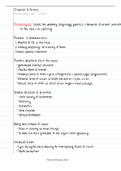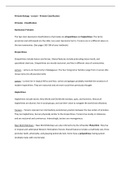Strepsirhines - Study guides, Class notes & Summaries
Looking for the best study guides, study notes and summaries about Strepsirhines? On this page you'll find 7 study documents about Strepsirhines.
All 7 results
Sort by
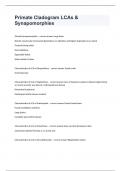
-
Primate Cladogram LCAs & Synapomorphies verified already passed 2024/2025
- Exam (elaborations) • 2 pages • 2024
- Available in package deal
-
- $9.99
- + learn more
Primate Cladogram LCAs & Synapomorphies verified already passed 2024/2025 Primate Synapomorphies - correct answer Large brain Shorter snouts (due to lowered dependence on olfaction and higher dependence on vision) Forward facing orbits Post orbital bar Opposable hallux Nails instead of claws Characteristics of LCA of Strepsirhines - correct answer Tooth comb Grooming claw Characteristics of LCA of Haplorhines - correct answer Loss of tupetum Lucidum (reduced night vision) so...
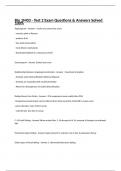
-
Bio 1M03 - Test 2 Exam Questions & Answers Solved 100%
- Exam (elaborations) • 23 pages • 2024
-
- $12.49
- + learn more
Angiosperms - Answer - ovules are covered by ovary - vascular plant w flowers - produce fruit - has seeds (innovative) - most diverse land plants - dominated habitats in cretaceous period Gymnosperm - Answer Ovules lack cover Relationship between Angiosperms/Animals - Answer - Coevolved (complex) - Animals assist with pollination/defense/disperal - Animals are rewarded with nect/fruit/shelter - Allows for development of niches/diversification Dating Ocean Core Strata - Answer -...
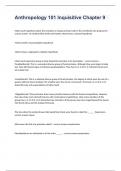
-
Anthropology 101 Inquisitive Chapter 9 with 100% correct answers
- Exam (elaborations) • 6 pages • 2024
-
Available in package deal
-
- $12.99
- + learn more
Anthropology 101 Inquisitive Chapter 9 Match each hypothesis about the evolution of unique primate traits to the scientist(s) who proposed it. - correct answer -Sir Grafton Elliot Smith and Frederic Wood Jones: arboreal hypothesis -Matt Cartmill: visual predation hypothesis -Robert Susan: angiosperm radiation hypothesis Match each taxonomic group of early haplorhine primates to its description. - correct answer -Propliopithecids: This is a somewhat diverse group of fossil primates. Alt...
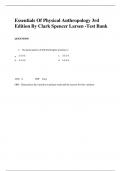
-
Essentials Of Physical Anthropology 3rd Edition By Clark Spencer Larsen -Test Bank
- Exam (elaborations) • 50 pages • 2024
-
- $7.09
- + learn more
5. The two suborders of primates are: a. platyrrhine and catarrhine. c. pongidae and hominidae. b. prosimians and anthropoids. d. tarsiers and anthropoids. ANS: B DIF: Easy OBJ: Compare and contrast the two suborders of primates (prosimians and anthropoids) in terms of body form, body size, and dental morphology TOP: What are the kinds of primates? MSC: Remembering 6. While at the zoo you see an exhibit with a small group of primates and notice they have wet, snout-...
Chapter 6 Notes - Primates
The two main taxonomic classifications of primates are strepsirhines and haplorhines. The terms prosimian and anthropoid are the older, less used, taxonomic terms.
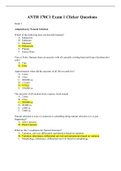
-
ANTH 170C1 Exam 1 Clicker Questions Latest 2021...
- Exam (elaborations) • 10 pages • 2021
-
- $13.49
- + learn more
ANTH 170C1 Exam 1 Clicker Questions Exam 1 Adaptation by Natural Selection Which of the following does not describe humans? A. Eukaryotic B. Eutherian C. Mammal D. Prokaryotic E. Primate F. Genus Homo True or False: Humans share an ancestor with all currently existing bacterial (type of prokaryote) cells? A. True B. False Approximately when did the ancestor of all life on earth live? A. 2 mya B. 2 bya C. 200,000 ya D. 3.5 mya E. 3.5 bya F. 350,000 ya The ancestor...

Do you wonder why so many students wear nice clothes, have money to spare and enjoy tons of free time? Well, they sell on Stuvia! Imagine your study notes being downloaded a dozen times for $15 each. Every. Single. Day. Discover all about earning on Stuvia

